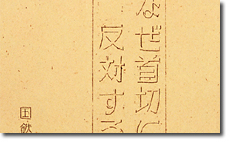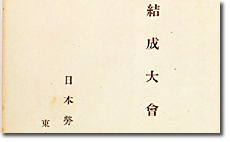HOME > Reconstruction of Japan > d. Shift in Occupation Policies and Recovery of Independence > Labor Movement
5-11 Labor Movement

Inaugural Conference of the General Council of Trade Unions in Japan, July 11-12, 1950 (Showa25) (poster) (Collection of Ohara Social Research Institute, Hosei University)
In December 1945 (Showa 20), the Labor Union Law was enacted, leading to the formation of many unions in Japan. As Occupation policy, however, shifted with the intensification of the Cold War, GHQ and the Japanese Government also increased their pressure on the labor movement. July 1948 (Showa 23) saw the issuance of Government Ordinance #201, based on a directive from General MACARTHUR, which denied public servants the right to enter into collective bargaining and to strike.
On 1 June 1949 (Showa 24), the state owned Japan Government Railways (JGR) was reorganized as the public corporation, Japan National Railways (JNR), formally independent of state control. With that shift came a massive layoff of workers, based on the law restricting the number of public employees, and it was announced that almost 90,000 railway workers would lose their jobs.
The Japan National Railways Workers' Union had started preparations for a labor struggle to oppose the layoffs, when several incidents in July 1949 occurred, the SHIMOYAMA Incident and the Mitaka Incidents put on end to the struggle. Subsequently, the layoffs were carried out almost exactly as planned.
Amidst these developments, a split occurred in the labor union movement as a more moderate current emerged in opposition to the militant leftists, with the organization of such groups as the anti-communist Democratization League (Mindo). Then, in July 1950 (Showa 25), the General Council of Trade Unions of Japan (Sohyo) was formed, centered on the Mindo. Sohyo then became the nucleus of the postwar labor movement in Japan, acting as the umbrella organization for nearly half of all organized workers.
Why Object to Being Fired?
- 12 May 1949 (Showa 24)
- Papers of ASANUMA Inejiro, #1978
- National Diet Library
"Documents Related to the Inaugural Rally of the General Council of Trade Unions of Japan: Statement of Purposes, Inaugural Rally"
- 11-12 July 1950 (Showa 25)
- Papers of ASANUMA Inejiro, #1987
- National Diet Library
- From "Documents Related to the Inaugural Rally of the General Council of Trade Unions of Japan"

